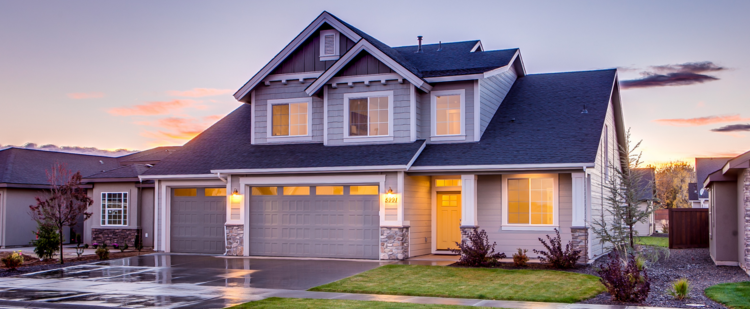
Understanding the 80% Rule for Home Insurance
When it comes to your home, making sure you’re adequately insured is of the utmost importance. Despite this, many homeowners are unaware of the “80% rule” for home insurance and, as a result, find themselves underinsured when trying to replace their personal property after a loss. Understanding the 80% rule—and following it—can help you protect yourself and your home.
The Basics
There are two valuation options available when purchasing insurance on your home. Typically, homeowners can elect to insure their home and personal property on an Actual Cash Value basis or at replacement cost. Actual Cash Value refers to the amount needed to repair or replace an item, minus depreciation (the decrease in the value of your home or personal property due to normal wear and tear). Replacement cost refers to the amount needed to repair or replace your damaged property with materials of similar kind and quality without deducting for depreciation.
Most insurance companies require homeowners to purchase replacement cost coverage worth at least 80% of their home’s replacement cost in order to receive full coverage. For example, if you bought your home for $275,000, you would need to have insurance for at least $220,000 for the insurance company to fully cover any potential claims.
Many homeowners follow the 80% rule when first purchasing their home but are unaware of the importance of adjusting their coverage to keep up with the changes inflation and home improvements can make to their home’s overall replacement cost. As a result, these homeowners are surprised after a disaster or loss when an insurance company doesn’t cover the total cost of replacing their home. Without having at least 80% of the replacement cost of your home insured, your insurance company may only pay the difference between 80% of the replacement cost of your home and the amount of coverage you purchased.
The 80% Rule in Action
Following the example above, let’s say you secured insurance for $220,000—or 80% of the replacement cost of your home—when you first purchased it. Then, you renovated your home, and these improvements significantly raised the replacement cost of your home to $350,000. For your insurance company to fully cover claims, you’d need to increase your insurance coverage to reflect 80% of the new replacement cost of your home, which would be $280,000 in this case. A storm causes $100,000 of damage to your home, but because you increased the amount of insurance on your home to $280,000, the insurance company covers the total cost of the repairs, minus your deductible.
Let’s say you didn’t adjust your insurance coverage, so you only had $220,000 in coverage for your home that is now worth $350,000 to replace. Instead of having at least 80% of the new replacement cost of your home insured, which would be $280,000, you only have 62.86% of the total cost insured. In the event of a claim, the insurance company would divide the amount of coverage you purchased ($220,000) by 80% of the replacement cost of your home ($280,000) and only cover the difference between those two amounts. So, in the same scenario from above, instead of the insurance company paying the full $100,000 (minus your deductible) to repair the damage caused by the storm, they would only pay roughly $78,570, as the difference between the amount of insurance you purchased and the 80% replacement cost was 78.57%. You would then be responsible for paying the remaining $21,430 in repair costs, plus your deductible.
As you can see, failing to adjust the amount of insurance you have on your home to ensure you’re following the 80% rule can be extremely costly. Regularly reviewing your coverage amounts, especially after you’ve done home renovations, can help you make sure you’re properly covered, even if your home’s replacement cost increases.
What Affects the Replacement Cost of My Home?
Because the 80% rule is directly affected by any changes to your home’s replacement cost, it’s important to understand what can affect the replacement cost value of your home. While every policy varies, some of the most common things that affect your home’s replacement cost value are:
- Square footage of your home
- Home renovations and improvements (e.g., changing flooring, appliances and fixtures; updating a roof; or installing new windows)
- Cost of replacing materials
- Labor costs in the event repairs are needed
- Value of interior and exterior components
It’s important to note that the market value of your home does not necessarily affect your home’s replacement cost. As such, things like curb appeal, the condition of your home and the value of comparable homes in your area may not affect your replacement cost value. Be sure to talk to your representative at Sanford & Tatum, A Heritage Risk Management Company so you can understand what may affect the replacement cost value of your home under your policy.
Make Sure You're Not Underinsured
Securing adequate coverage for your home, especially as the replacement cost value changes over the years, is essential in protecting your home and your wallet. Contact Sanford & Tatum, A Heritage Risk Management Company today to make sure you have sufficient coverage under the 80% rule for homeowners insurance.
© 2021 Zywave, Inc. All rights reserved. This Know Your Insurance document is not intended to be exhaustive nor should any discussion or opinions be construed as legal advice. Readers should contact legal counsel or an insurance professional for appropriate advice.

Discussion
Thomas Clarence
Friday, October 15, 2021 at 4:52pm CDT
Thank you for helping me to understand more about how home insurance works. My wife and I need to purchase home insurance. We have never done this before, so it might be a good idea for us to find a professional that can guide us.
Greta James
Friday, January 28, 2022 at 6:42am CST
Wow, I have never considered the need to change home insurance as the value of a home rises. Thank you for the advice. My husband and I are going to buy a home this spring and I will definitely keep this in mind. It would be a good idea for us to consult with an insurance expert so we get the right coverage for our needs.
Charlotte Fleet
Tuesday, November 9, 2021 at 4:06pm CST
Thank you for your tips on understanding home insurance. My husband and I need to get homeowners insurance for our house. We will use your article to choose the best coverage.